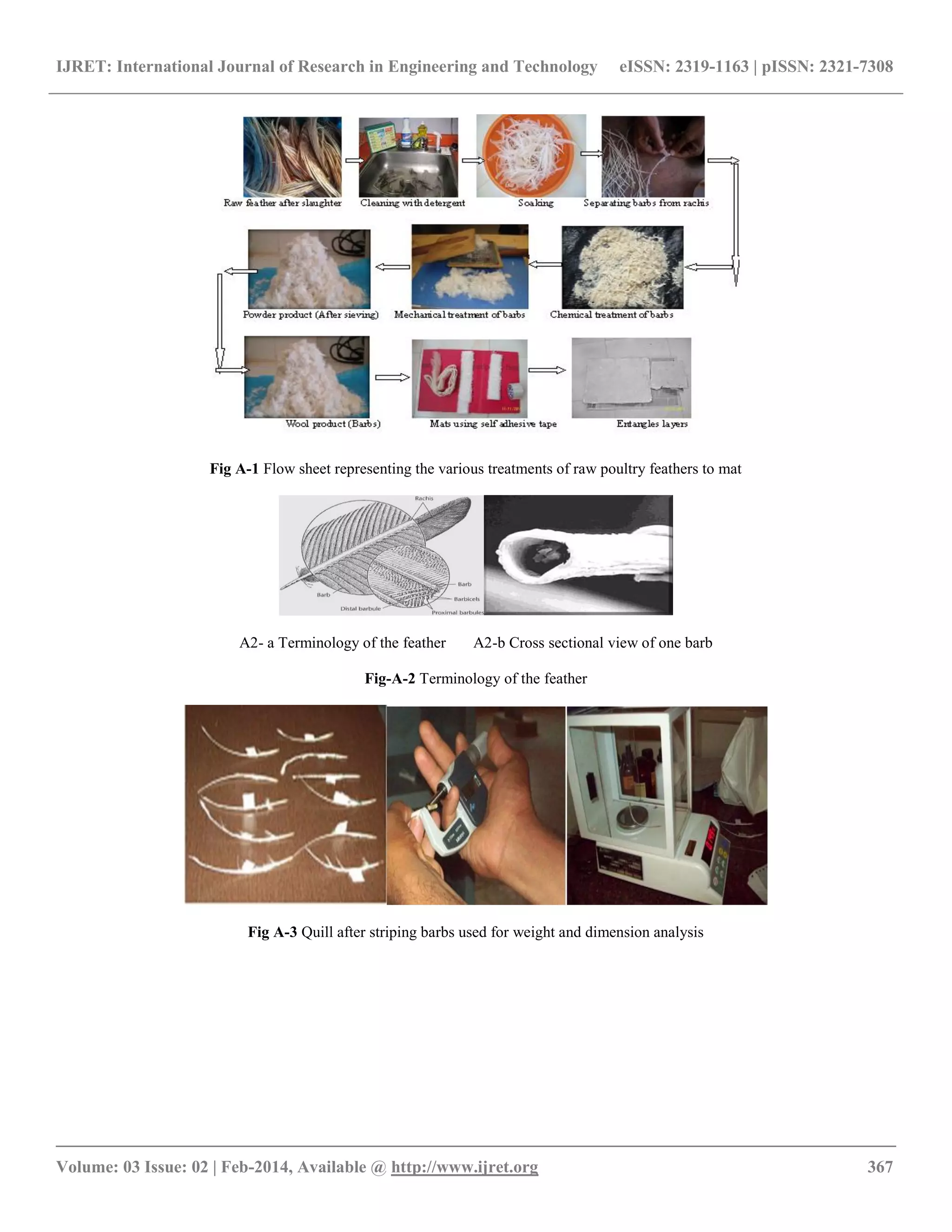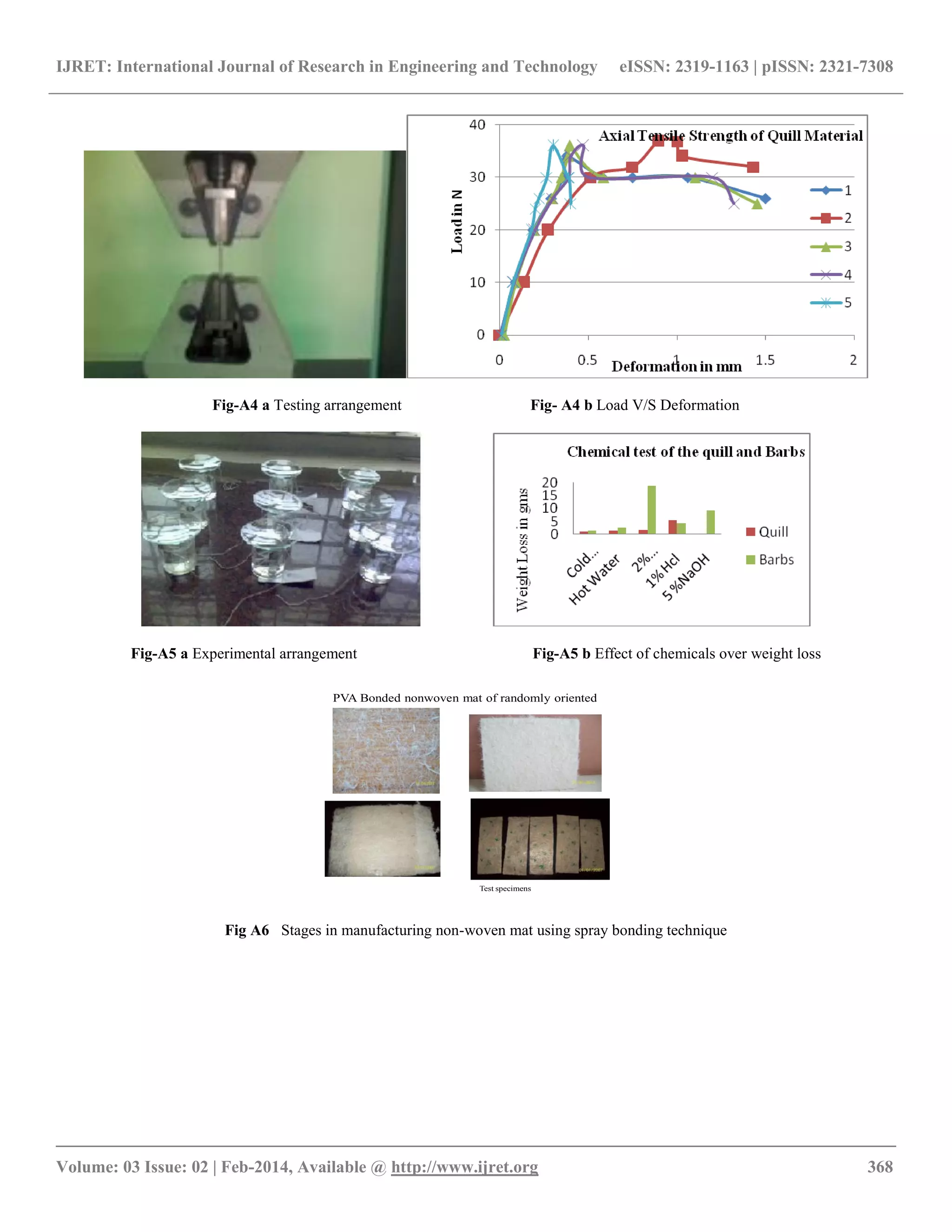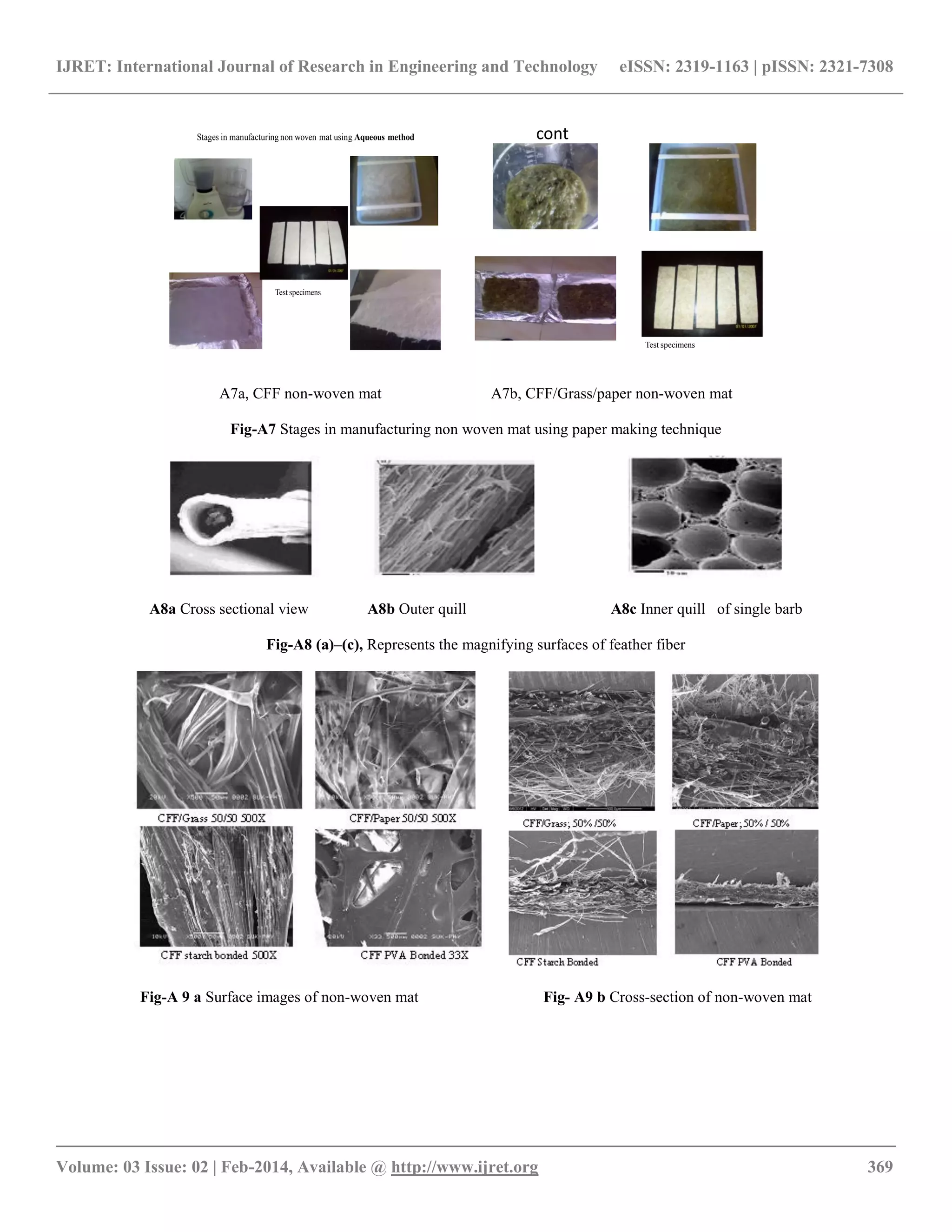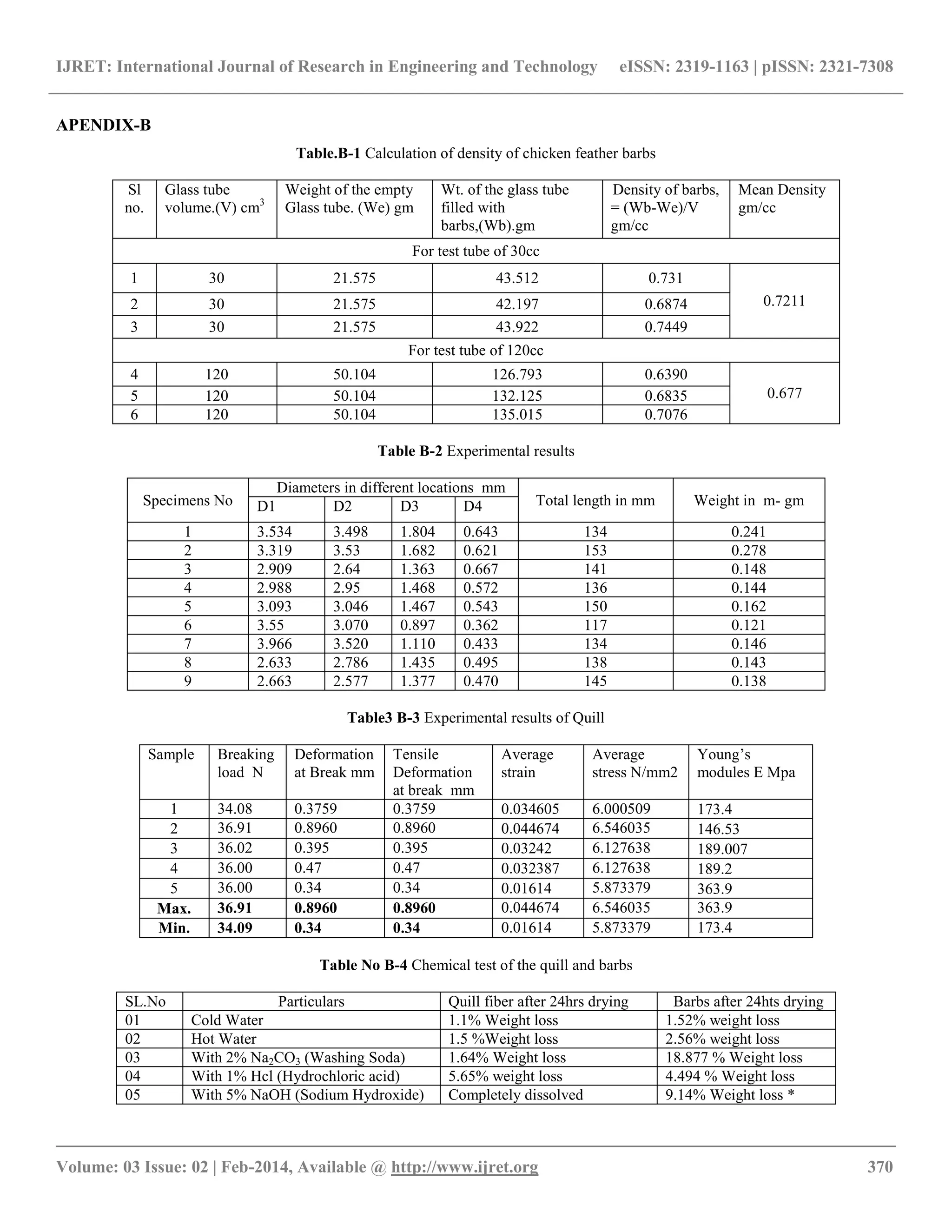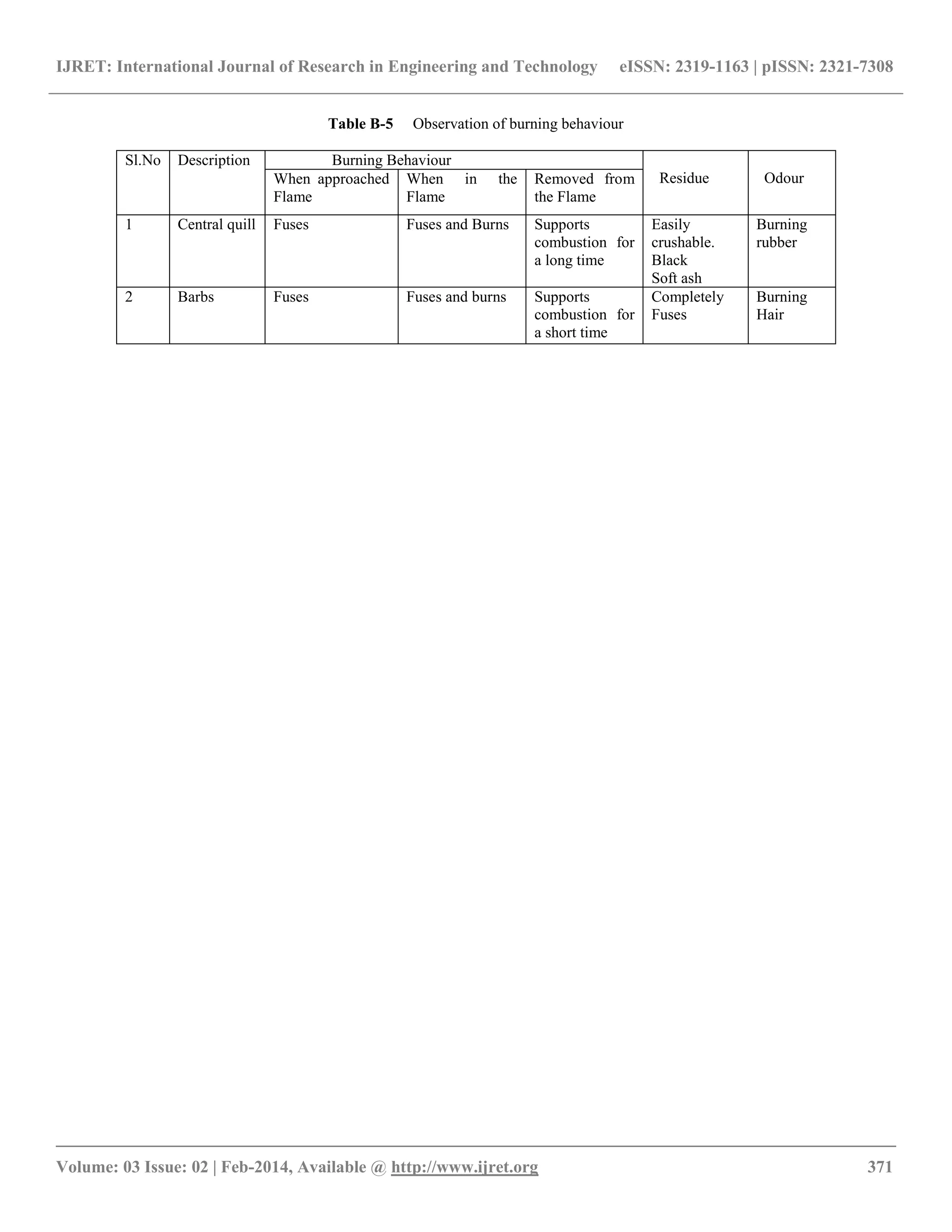This study investigates the potential of chicken feather fibers as a reinforcing material for composites, highlighting their advantageous properties such as high protein content and low density. The research includes experimental analysis of the fibers' physical and mechanical characteristics and explores methods for creating nonwoven mats from the fibers. Findings suggest that chicken feather fibers can enhance the environmental sustainability and commercial viability of composite materials.
![IJRET: International Journal of Research in Engineering and Technology eISSN: 2319-1163 | pISSN: 2321-7308
__________________________________________________________________________________________
Volume: 03 Issue: 02 | Feb-2014, Available @ http://www.ijret.org 362
EXPERIMENTAL STUDY OF BEHAVIOUR OF POULTRY FEATHER
FIBER - A REINFORCING MATERIAL FOR COMPOSITES
K B Jagadeeshgouda1
, P Ravinder Reddy2
, K Ishwaraprasad3
1
Assistant Professor, Dept of Mech Engineering S G Balekundri Institute of Technology Belgaum and Research scholar
JNTUH, India
2
Professor and Head, Department of Mechanical Engineering, CBIT Hyderabad -75, AP, India
3
Professor, Department of Mechanical Engineering & Director of evaluation, J N T U Hyderabad, India
Abstract
Currently, the abundant quantity of chicken feather produced annually by the poultry industry as a waste in worldwide, is a serious
solid agricultural waste problem. The traditional disposal strategies of chicken feather were not environmental friendly. Exploitation
of secondary application alone is not a solution to the problem of environmental; also it enhances the commercial value of feathers. In
this study, a review on the behaviour of the chicken feather fibers was made to understand their usability as a reinforcing material for
composite fabrication. Fibers of some critical length were estimated experimentally and calculated relative density. Tensile property
of fiber, dimensional and strength of the quill was estimated. It was observed that, the quill diameters were varying with length, and
all of them were not weighing same. Chemical resistivity and burning tests were conducted, and results were reported. Morphology of
the nonwoven mats was studied.
----------------------------------------------------------------------***--------------------------------------------------------------------
1. INTRODUCTION
Natural fibers have been used to reinforce materials for over
thousand years. Recently, they have been employed in
combination with plastics. Natural fibers are environmentally
friendly, fully biodegradable, abundantly available, renewable
and cheap and have less density. Natural fibers pose no health
hazards and, finally, provide a solution to environmental
pollution by finding new uses for waste materials. Currently,
many types of natural fibers have been investigated for use in
plastics including flax, hemp, jute straw, wood, rice husk,
wheat, cane (sugar and bamboo), grass, reeds, kenaf, ramie, oil
palm empty fruit bunch, sisal, coir, water, hyacinth,
pennywort, kapok, banana fiber, pineapple leaf fiber. Fibers
obtained from the various parts of the plants are known as
vegetable fibers. Animals can also provide a source of fibers.
Natural fibers are emerging as a viable alternative to man-
made fibers, particularly in automotive, packaging, building,
and consumer product industries, and becoming fastest
growing reinforcing material. A wide variety of properties can
be achieved through proper selection of fiber type, fiber
orientation and fiber reinforcement form. [1]. Natural fibers
can be obtained from animals too. Reports on using animal
fibers as reinforcing fibers are rare. Currently, the abundant
quantity of poultry feathers produced annually by the poultry
industry as a waste which can be effectively used as a
reinforcing material. Around 24 billion chickens are killed per
year across the world, which are discarded around 8.5 billion
tons of feathers, in which India‟s contribution alone is 400
million tonnes.India was ranked the fifth largest poultry
producer in the world[2]. Poultry feathers are approximately
91% protein (keratin), 1% lipids, and 8% water [3]. The amino
acid sequence of a poultry feather is very similar to that of
other bird‟s feather. Chicken feathers are approximately half
feather fibre and half quill (by weight). The feather fibre and
quill are both made from hydrophobic keratin, a protein that
has strength similar to nylon and a diameter smaller than wood
fibre[4]. The fibre is more durable and has a higher aspect
ratio than the quill. Feathers can‟t be taken from the chicken
and made directly into new materials. The stiff central core of
the feather (quill) must be stripped of from the barbs. This soft
barb material can be used as reinforcing material. Although
the whole feather is made of keratin, the crystal structure of
the protein in the brittle central quill is different from that in
the soft but durable barbs; only the barbs have the desirable
properties [5]. Feather barbs are too short to allow them to
spun into thread and woven into cloth, but they can be mixed
with man-made materials to prepare slab or mat of randomly
oriented type. The length of the barbs is depending on the
region location along the rachis. The barbs located at the base
of the rachis are so long than those at the tip. A physical and
mechanical property of the chicken feather depends upon the
percentage of keratin protein present, which generally varies
with ecological condition of the bird [5-9]. To aid the
development of successful applications for poultry feather
fiber in composite making; this work has been taken up. The
objective of this investigation is to develop processing and
testing of both fiber and quill. Also, attempt has been made to
prepare a nonwoven mat form feather fiber using papermaking
and spray bonded technique.](https://image.slidesharecdn.com/experimentalstudyofbehaviourofpoultryfeatherfiber-areinforcingmaterialforcomposites-140811023511-phpapp02/75/Experimental-study-of-behaviour-of-poultry-feather-fiber-a-reinforcing-material-for-composites-1-2048.jpg)
![IJRET: International Journal of Research in Engineering and Technology eISSN: 2319-1163 | pISSN: 2321-7308
__________________________________________________________________________________________
Volume: 03 Issue: 02 | Feb-2014, Available @ http://www.ijret.org 363
2. EXPERIMENTAL APPROACH
2.1 Cleaning of Feathers
Broilers are chickens both male and female that will be
slaughtered for meat at about 5 to 8 months old depending on
weight and layers are produced to lay eggs then moved for
slaughter. In the present work, the required raw material was
obtained from Boiler chicken after processing for meal.
Feathers (CF) directly collected from a chicken processing
plant or slaughterer are always dirty and contain various
foreign materials, such as skin, blood, feces and flesh. Initially
feathers were washed many times with hot water with
detergent and dried. After drying quills were separated by
stripping from barbs, since they differ physically. Initially
barbs were mechanically treated to convert them into wool
form and used suitable straining device to separate out coarser
elements. Then the fibers are cleaned in running water and
dried. A solution was prepared in a glass beaker by adding 6%
NaOH to distilled water. Mechanically treated and dried fibres
were soaked in a solution for three hours and then washed in
running water. These were dried for 10 hours in natural light.
These barb fibres were used for estimating physical properties
like density, aspect ratio and strength. Advantage of chemical
treatment (with NaOH) is to remove moisture content from the
fibres thereby increasing its strength. Also, chemical treatment
enhances the flexural rigidity of the fibres and stabilizes the
molecular orientation. Figure-A1 represents the technique
used in the laboratory so as to process the raw poultry feathers
into useful fibers for further processing [10, 11]. Figure-A2a
and A2b shows the terminology of the feather and cross
sectional view of single barb.
2.2 Calculation of Apparent Density of Fiber
It has been reported that the density of chicken feather fibre,
provided by Tyson Foods, Inc., is 0.8 g/cm3. This value is
interpreted as an apparent density value because it is not the
weight of a solid matter, but instead it is the weight of a
volume of both solid matter (the walls of fiber) and air (the
hollow inside the fiber). Hong and Wool reported a typical
value of 8 mm for fiber length [1]. Barone and Schmidt [12]
measured the density of chicken feather fiber, obtained from
feather fiber Corporation, by displacing a known volume and
weight of ethanol with an equivalent amount of fiber. They
reported a value of 0.89 g/cm3 for the chicken feather fiber.
Barone and Schmidt reported fiber lengths of 3.2-13 mm. In
the present work, fibre is being used for further investigation
of some critical length by neglecting the void inside the fibers
were estimated experimentally and calculated relative density
using a formula
Density (ρ ) =Mass (m) / volume (V)---Eq.No 1
2.3 Aspect Ratio of Feather Fibers
A fiber is characterised geometrically not only by its very high
length-to-diameter ratio but by its near crystal sized diameter.
Strength-to-density and stiffness-to-density ratios are
commonly used as indicators of the effectiveness of a fiber,
especially in weight-sensitive applications like aircraft and
space vehicles. Barone and Schmidt [12] examined chicken
feather fiber from Feather fiber Corporation. Barone and
Schmidt found that fibers had a constant diameter of
approximately 5 μm and lengths between 3.2 and 13 mm.
These values correspond to aspect ratios of 600-2600. Kar and
Misra [13] measured by scanning electron microscopy the
diameter of chicken down feather fibers obtained from MaXim
LLC. Fiber diameters were found to be in the range of
5μm.Dweib et al. [14] examined chicken feather fiber from
Feather fiber Corporation. These fibers were reported to have
diameters of 6-8 μm and lengths of 3-13 mm. These values
correspond to aspect ratios of 400-2200.Values for chicken
feather fibers obtained from Tyson Foods, Inc. was reported
by Hong and Wool [1]. Hong and Wool reported typical
values of 6 μm for fiber diameter, 8mm for fiber length, and
1000 for fiber aspect ratio. In the present work author
measured the diameter of the down feather barbs obtained
from local slaughter by optical microscope .Average diameter
was found to be in the range of 5-6 µm and length of 3-
22mm.These values corresponding to aspect ratio of 600-
3667.
2.4 Fiber Strength
Authors measured the tensile strength of chicken feather fiber
directly. Fibers were held by adhesive tape and tested in
tension with a crosshead speed of 1.3 mm/min. Fiber diameter
was measured with an optical microscope and used to
determine fiber area. Fiber area was estimated in the range of
1. 9635X10-5
– 2.827 X10-5.
mm2
. Author has reported that
strength results varied due to the heterogeneity of the fibers.
Strengths ranged from 40-123 Mpa. Tensile test was
conducted on a universal testing machine (Instron Model
5565) of 0-500 Kg capacity.
2.5 Tensile Test of Quill
Feathers quill must bend under the aerodynamic forces
generated during flight while also being very lightweight. The
mechanical properties of chicken feather are related to the
structure of natural protein or keratin present in feather.
Keratin, like other biological polymers, possesses a structure
with covalent bonds that transfer forces while only negligibly
distorting. Strains are largely produced by changes in the
hydrogen bonds, van der Waals, and Coulombic interactions.
According to Feughelman [15], consistency among natural
protein fibers results in similar moduli of elasticity. However,
Bonser and Purslow‟s [16] summary of studies since 1966
reports moduli of elasticity for feather keratin ranging from
0.045 Gpa to 10 Gpa. Bonser and Purslow [16] performed uni-](https://image.slidesharecdn.com/experimentalstudyofbehaviourofpoultryfeatherfiber-areinforcingmaterialforcomposites-140811023511-phpapp02/75/Experimental-study-of-behaviour-of-poultry-feather-fiber-a-reinforcing-material-for-composites-2-2048.jpg)
![IJRET: International Journal of Research in Engineering and Technology eISSN: 2319-1163 | pISSN: 2321-7308
__________________________________________________________________________________________
Volume: 03 Issue: 02 | Feb-2014, Available @ http://www.ijret.org 364
axial tension tests on 25 mm sections of keratin cut from the
rachis dorsal surface of flight feathers from different species.
The Young‟s modulus was found to be approximately 2.5 Gpa
for all species. Bonser and Purslow also found the Young‟s
modulus to increase markedly along the length of the rachis,
with the highest values at the feather tip. To explain this, they
considered a swan‟s primary feather to act as a simple airfoil
in a laminar flow. Since the drag profile is proportional to the
thickness/diameter of the rachis, an increase in flexural
strength towards the tip would allow for a smaller shaft
diameter.Cameron et al. [17] confirmed that the mechanical
properties of feather keratin vary appreciably along the length
of the rachis. The swan and goose feathers both proved to be
functionally gradient, with Young‟s modulus varying from
2.5-3.0 Gpa at the calamus to 4.5-5.0 Gpa at the rachis tip. The
ostrich feathers had a significantly lower modulus and did not
show an increase along their length. George et al. [18] studied
turkey feather fiber properties for fibers at different positions
along the rachis. It was found that both the tenacity and
modulus of turkey feather fiber, increased with the distance
from the calamus. Purslow and Vincent [19] measured the
elastic modulus of feather rachis from pigeons, with and
without inner quill. Dehydrated feather rachises were tested in
bending. Elastic modulus values for the rachis with inner quill
were greater than values for rachis without inner quill.
2.5.1 Dimensional Test of the Quill
Feathers spread over the bird are varying in size depends upon
the location. Based on the location; feathers are identified as
primary and secondary feathers. Primary feathers are at the
region of the wings and are not in uniform size. To optimise
weight and diameter author has taken this work. In this test
author estimated the average weight of the quill by selecting
samples. These samples were weighted in weighing machine
of model No 7301A in a laboratory. Using Mitutoyo Digimatic
micrometer (Fig.A3) the dimensions of the quill along the
length was estimated. Along the length of the specimen, we
marked four locations at a specific distance for measurement
purpose. Table- B2 represents the recorded readings.
Tensile test was carried out according to ASTM test standards
D 638 in the universal testing machine for quill (shaft) portion
to estimate average strength. Figure A4 (a) represents the
arrangement for tensile test and Figure A4 (b) represents load
verses deflection of quill portion. Test results are shown in
Table -B3.
2.6 Chemical Test of Quill and Barbs
Quill and barb fiber samples those harvested for a month were
tested with 2% Na2CO3, 1%Hcl and 5%NaOH for the duration
of 2hrs, 8hrs and 24hrs. Fig-A5 represents an experimental
arrangement for the test. After 24 hours of drying at room
temperature, they were reweighted. Average observations are
tabulated in Table-B 4
2.7 Burning Test
This test was conducted to know the behaviour of the feather
and the quill when they are subjected to fire and high
temperature. Table-B5 represents the observations during the
test.
3. PREPARATION OF FEATHER FIBER MAT OF
NON-WOVEN TYPE
An average length of the barbs is about 6-22mm, so it was
difficult to prepare either a yarn or weaving, hence chopped
mat concept was used to obtain the nonwoven mats,
that provide equal strength in all directions. Initially,
mechanically treated fibers were socked in a corn starch
solution prepared with a known quantity of water for 30
minutes under room temperature and then using papermaking
technique sheets of required size had produced, and then laid
on wax coated aluminium foil. It was allowed to dry naturally
for 24hrs and then hot pressed in a hydraulic press with a
heating system and later trimmed to the required size.[20-23]
Also, non-woven mat had produced by spray bonding
technique using PVA. Trials were made to blend the chicken
feather fiber with grass pulp and paper pulp to make non-
woven mat and got a good result [24-27]. Fig A6& Fig A7
represents the stages of manufacturing non-woven mats of
respective technique.
4. RESULTS AND DISCUSSION
4.1 Assessment of Apparent Density
Hence it is observed that, average recorded relative density of
the barbs is 0.7gms/cc. The difference in results may be
related to composition differences between the chicken feather
fibres samples studied. The hollows, or voids, inside chicken
feather fibres may become more accessible to air or any fluid
as fibre length decreases. From Table-B1, it was observed that,
chicken feather fiber has shown very close values of apparent
density in both trials in the range of 0.677-0.72 g/cc.
Compared with other animal and plant fibers, like silk
1.17g/cc, wool 1.31 g/cc and cotton 1.5-1.6 g/cm3, jute 1.3
gm/cm3, coir 1.2g/cm3 etc density of chicken feather fiber
was observed less. Thus, chicken fiber inclusion in a
composite could potentially lower composite density, whereas
the density of a typical composite with synthetic reinforcing
increases as fiber content increases. Thus, substantial savings,
in terms of transportation and construction costs, could be
derived from the use of lightweight composites containing
chicken fiber.
4.2 Assessments of Aspect Ratio and Fiber Strength
Usually ends of fibers have lower load carrying ability and
hence higher the ends lower will be the load carrying capacity
of the composite. Longer the fiber, number of ends will be less
and hence higher will be the load carrying capability. In
general strength of the composite is decided by the critical](https://image.slidesharecdn.com/experimentalstudyofbehaviourofpoultryfeatherfiber-areinforcingmaterialforcomposites-140811023511-phpapp02/75/Experimental-study-of-behaviour-of-poultry-feather-fiber-a-reinforcing-material-for-composites-3-2048.jpg)
![IJRET: International Journal of Research in Engineering and Technology eISSN: 2319-1163 | pISSN: 2321-7308
__________________________________________________________________________________________
Volume: 03 Issue: 02 | Feb-2014, Available @ http://www.ijret.org 365
length of the fiber. If the length of the fiber is longer than the
critical length; strength of the composite will be higher.
Another factor which decides the strength of the composite is
the aspect ratio (l/d).If the aspect ratio is greater than 15, the
fiber is termed as continuous, and otherwise it is termed as
discontinuous [29].
It was observed that, diameter and length of fibers were
varying from location to location, so, average aspect ratio was
greater than 15, hence chicken feather fibers are considered as
continuous. Since chicken feather fibers are naturally smaller
in length which accommodates more number of fibers for the
same volume fraction, hence increase in surface area and
number of flaws (defects) reduced which intern improves the
efficiency of load transfer ability.
4.3 Assessment of Tensile Strength
From the Table-B2 it was cleared that, all samples measured
different diameters at different location of each samples, also,
measured different length and weight. From the Fig-A4b it
was observed that, all quill samples behaves like an elastic
material, and also it was observed that, material having good
stiffness since, it has represented very less elongation. From
the Table- B3 it was observed that from the 5 samples,
maximum young‟s modules were 363.9 Mpa and the
minimum was 173.4 Mpa, this difference might be due to
variation in the cross-sectional area of an individual quill. In
most of the applications uniform fiber cross section and its
length is very important to distribute load uniformly, hence,
quill can‟t be used directly as a reinforcing material.
4.4 Assessment of Chemical Resistance and Burning
Test
Moisture sensitivity is one of the most serious problems of
natural fiber, and natural fiber reinforced composites whereby
these fibers swell and rot. Hence, quill and barb fiber samples
those harvested for a month were tested with 2% Na2CO3,
1%Hcl and 5%NaOH for the duration of 2hrs, 8hrs and
24hrs.It was observed that, quill weight was increased by
35%-40% and also, barbs weight was increased by 58%-65%
in all reagents except in 5% NaOH. Since feathers are
naturally porous, they can be used as fluid absorbers. After 24
hours of drying at room temperature, they were reweighted
and found losses in weight. From the Table-B4 also, it was
cleared that, quill looses less weight than barbs, but quill
completely dissolved in 5% NaOH after 24hrs, but barbs
looses its weight and became brittle. Treating fibers with
NaOH is essential for enhancing some of the properties but it
is not recommended to treat them for more then 1 hour to
maintain stability in the fibers. Average observations are
tabulated in Table-B4.Burning is one of the traditional
disposing methods of chicken feather fibers, so to understand
it environmental effect burning test was conducted separately
on barbs and quill in a laboratory on a selective quantity of
samples.From the Table-B5, it was observed that, quill burns
continuously with burning rubber odour left with black soft
ash, whereas barbs completely fuses and has not supported
continuous burning but liberated odour like burning human
hair
4.5 Assessment of Nonwoven Manufacturing Process
and its Morphology
Soft part of the feather is easy to handle since it has uniform
cross-section bur varying in length which depends upon the
location of the soft fibers on the feather. Handling short fibers
with varying length was very difficult; hence authors have
introduced making nonwovens adopting existing aqueous and
spray bonding techniques. Only compression molding method
can be used by handling short fibers directly which will be
expensive for complicated component manufacturing. Hand
layup technique is most popular technique used in an
automotive industry, which requires reinforcing material in the
form of nonwoven sheet. Hence we proved the aqueous and
spray bonded techniques can be effectively used for
manufacturing nonwovens.Fig-A6 & Fig-A78 shows the steps
involved in the processing of nonwovens. Non-woven mats
prepared by both the methods were proved to be good to
prepare layered composite using hand layup technique.
Keeping future demand of chicken feather fiber nonwoven
mats, other waste products like garden lawn grass and waste
paper hand bills were mixed with chicken feather fiber and
obtained nonwoven sheets using the same techniques.
From morphological analysis, it was observed that, chicken
feather fibers properly mixed with other fibers in an aqueous
medium. The microstructure analysis shows that, poultry
feathers have hollow in nature so, they can absorb the fluids
and non-woven magnified surfaces showed interlocking
between the fibers to maintain stability of the mat. Fig-A9 a
shows the surface morphology and Fig-A9b represent the
cross-sections of the different composition nonwovens.
5. CONCLUSIONS
It will be concluded that considering the enormous amount of
feather produced in the poultry Industry as a waste material
and its low density, it is proposed to use it as a reinforcing
material for composites. From the morphological point of
view and the presence of hollow structures makes poultry
feather fibers to use as a fluid absorbent. Also, concluded that,
non-woven produced using CFF and composition with grass
and paper are easy to handle during preparation of
complicated components using hand layup technique and can
be used for interiors in passenger transportation vehicles.
Scope for further work is to test the nonwovens for its physical
and mechanical properties. These nonwoven sheets can be
used to prepare composites using hand layup technique.
REFERENCES](https://image.slidesharecdn.com/experimentalstudyofbehaviourofpoultryfeatherfiber-areinforcingmaterialforcomposites-140811023511-phpapp02/75/Experimental-study-of-behaviour-of-poultry-feather-fiber-a-reinforcing-material-for-composites-4-2048.jpg)
![IJRET: International Journal of Research in Engineering and Technology eISSN: 2319-1163 | pISSN: 2321-7308
__________________________________________________________________________________________
Volume: 03 Issue: 02 | Feb-2014, Available @ http://www.ijret.org 366
[1] Hong and Wool, 2005
[2] According to Indian market research bureau conducted
on April 13th
1994;
[3] Watt Poultry Guide 2004-05
[4] Martinez-Hernandez, Ana L.; Velasco-Santos, Carlos;
De Icaza, Miguel; Castano, Victor M.(2005);
Microstructural characterisation of keratin fibres from
chicken feathers; International Journal of Environment
and Pollution; 23(2), p 162-178
[5] W.F. Schmidt,”(1998) Innovative Feather Utilization
Strategies”, national Poultry waste Management
Symposium Proceedings,
[6] PN-EN ISO 5270: (2011): Fibrous pulps– Laboratory
sheets - Estimation of physical properties
[7] P. P. Purslow AND J. F. V. Vincent (1978);
Mechanical properties of primary feathers from the
Pigeon; exp. Biol., 73, 251-260
[8] Chen C, Chuanbao C, Xilan M, Yin T, Hesun Z(2006).
Preparation of non-woven mats from all-aqueous silk
fibroin solution with an electrospinning method.
Polymer. 47(18): 6322-7
[9] Wdowiak T.(1970) Technology to produce non-woven
by a paper-making method (In Polish). Przegląd
Papierniczy 94
[10] Saravana Bavan and GC Mohan Kumar,(2010)
“Potential use of natural fiber composite materials in
India” Journal of Reinforced Plastics and Composites
[11] US Patent 4169706-Method of cleaning poultry
feathers
[12] ARONE JR. (2005). Polyethylene/keratin fiber
composites with varying polyethylene crystallinity.
Composites Part A 36, 1518–1524
[13] Kar, P. and Misra, M. (2004). Use of Keratin Fiber fo r
Separation of Heavy Metals from Water, Journal of
Chemical Technology and Biotechnology, 79: 1313-
1319
[14] Dweib, M.A., Bullions, T.A., Loos, A.C., Wool, R.P.
(2004). Recycled Newspaper and Chicken Feathers as
Reinforcement Fiber in Bio-composite Materials.
ANTEC 2004 International Conference Proceedings
1478-1481
[15] Feughelman, M. (2002). Natural protein fibers. Journal
of Applied Polymer Science, 83: 489-507
[16] Bonser, R.H.C. and Purslow, P.P. (1995). The Young's
modulus of feather keratin. Journal of Experimental
Biology, 198: 1029-1033.
[17] Cameron, G.J., Wess, T.J., Bonser, R.H.C. (2003).
Young's modulus varies with differential orientation of
keratin in feathers. Journal of Structural Biology , 143:
118–123.
[18] George, B.R., Bockarie, A., McBride, H., Hoppy, D.,
Scutti, A. (2003b). Keratin Fiber Nonwovens for
Erosion Control Natural Fibers, Plastics, and
Composites – Recent Advances . Kluwer Academic
Publishers. p67-81.
[19] Purslow, P.P. and Vincent, J.F.V.(1978) Mechanical
Properties of Primary Feathers from the Pigeon. Journal
of Experimental Biology. 72:251-260
[20] Gassner III, G., Schmidt, W.F., Line, M.J., Thomas, C.,
Waters, R.M. (1998). Fiber and Fiber Products
Produced from Feathers. United States Patent #
5705030
[21] Gentry, R., Kurtis, K., Nanko, H. (2004). Development
of Value-Added Products from Chicken Feathers:
Paper, Wood Products, and Building Materials. TIP3
Proposal
[22] Chen C, Chuanbao C, Xilan M, Yin T, Hesun Z.
(2006)Preparation of non-woven mats from all-aqueous
silk fibroin solution with an electrospinning method.
Polymer. 47(18): 6322-7
[23] Wrześniewska-Tosik K, Marcinkowska M, Wawro D,
Mik T, Pałczyńska M.(2008) Paper-like materials with
poultry feather content. P. 386,554. Poland
[24] Kamath, M.G ,Dahiya A,Hegde R,(2004)”Chamical
bonding”
[25] Lunenschloss, J ,and Albrecht, W ,(1985),”Nonwoven
Bonded Fabrics”,John Wiley & Sons Inc,
[26] Meazey,A E ,(1971)”Binders used in Bonded Fiber
Fabric Production”,Nonwovens 71,The textile trade
press
[27] Oelkers,J.M, and Sweeney,E.J ,(1988)Latex Binders
and Bonding Techniques of Disposables”
[28] Vasanth kumar,Dr.Bhaarathi dhurai”Composite with
smart fibrous material”
[29] Text book „Jones,(1999) Mechanics of composite
materials
APENDIX –A](https://image.slidesharecdn.com/experimentalstudyofbehaviourofpoultryfeatherfiber-areinforcingmaterialforcomposites-140811023511-phpapp02/75/Experimental-study-of-behaviour-of-poultry-feather-fiber-a-reinforcing-material-for-composites-5-2048.jpg)
